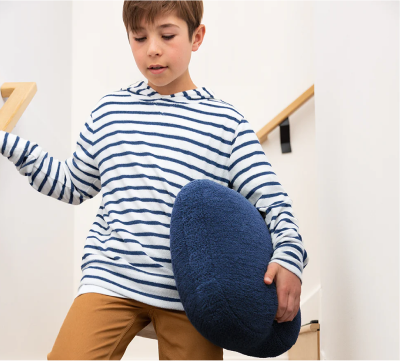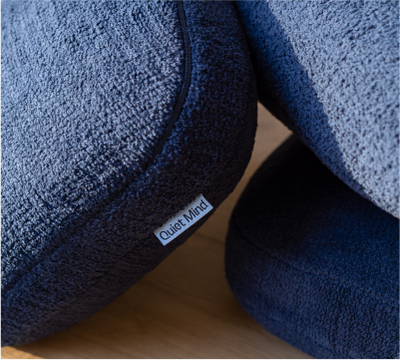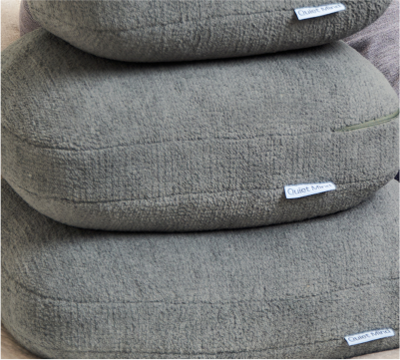ADHD is more than just hyperactivity or forgetfulness—it’s a condition that affects how you regulate emotions, focus your attention, and navigate everyday challenges. The experience of feeling “too much” all at once—noise, thoughts, movement, emotions—can lead to overwhelm, agitation, and a desperate need to find calm.
For those living with ADHD (or supporting someone who does), learning how to create moments of calm—both quickly and sustainably—is key. This guide offers supportive, natural strategies to help you regulate in the moment and build resilience over time.
Understanding What It Means to “Calm Down ADHD”
Is ADHD a Hyperactivity Problem or a Regulation Issue?
Many still associate ADHD primarily with fidgeting, bouncing off the walls, or a lack of discipline. But that view misses a crucial truth: ADHD is fundamentally a self-regulation disorder, not just a hyperactivity issue.
This condition affects how your brain manages:
- Attention: Staying focused on tasks, especially when they’re boring or complex.
- Impulse control: Interrupting, blurting out, making impulsive decisions.
- Emotional regulation: Reacting strongly and struggling to calm down.
- Motivation: Starting or following through on tasks even with good intentions.
People with ADHD often know what they need to do but can’t access the executive function tools (planning, prioritizing, emotional regulation) needed to do it at that moment. That internal conflict can lead to frustration and self-blame, both of which disrupt calm even further.
How Emotional Dysregulation and Impulsivity Impact ADHD Minds
One of the most overwhelming and misunderstood parts of ADHD is the way it affects emotions. Even small events—a critique, a change in routine, loud noise—can trigger intense reactions. This isn't about being "too sensitive." It's neurological.
People with ADHD often experience:
- Sudden emotional surges (anger, sadness, anxiety)
- Difficulty recovering after being triggered
- Ruminating on past events or future worries
- Shame spirals after emotional outbursts
|
Common Triggers |
Emotional Response |
Resulting Challenge |
|
Loud environments |
Irritability or shutdown |
Difficulty focusing, overstimulation |
|
Feeling criticized |
Anger, defensiveness, or shame |
Relationship strain, emotional fatigue |
|
Task failure or pressure |
Anxiety or panic |
Procrastination, freeze response |
Understanding this emotional landscape is the first step in managing it. Calming down ADHD means learning how to soothe the nervous system before it spirals out of control.
Fast ADHD Relaxation Tips: Quick Ways to Calm Symptoms and Reset Focus
Sometimes the emotional floodgates open with no warning. These tools are designed to bring relief in the moment by helping your body and brain re-center.
Deep Breathing and Grounding Techniques for Managing Stress
Intentional breathing helps regulate the autonomic nervous system, moving you from fight-or-flight to a more relaxed state. It's fast, discreet, and completely free.
Try this breathing pattern:
- Inhale through the nose for 4 seconds
- Hold your breath for 7 seconds
- Exhale slowly through the mouth for 8 seconds
- Repeat 3–5 times
Pair this with grounding exercises to redirect attention from overwhelming thoughts to the present:
- 5-4-3-2-1 sensory grounding: Name 5 things you see, 4 you can touch, 3 you hear, 2 you can smell, and 1 you can taste.
- Carry a grounding object: Something small and tactile like a smooth stone or textured fidget. At home or in calm-down spaces, a weighted pillow can offer similar sensory comfort through deep pressure.
These techniques are especially helpful during emotional spikes, transitions, or crowded environments.
Using Movement and Physical Activity to Reset
Movement helps the ADHD brain regulate dopamine, which directly impacts attention and emotional stability. You don’t need a full workout—even a few minutes of movement can make a difference.
Quick movement resets:
- Do 15 jumping jacks
- Step outside and walk around the block
- Try wall push-ups or a 30-second plank
- Use resistance bands or stretch at your desk
- Bounce on a yoga ball or shake out your limbs
These physical actions “unstick” the brain from freeze mode, giving you a chance to return to tasks with better focus and less agitation. ADHD is an action-seeking brain—movement feeds it in healthy ways.
Music, Noise-Canceling, or Silence: What Works Best?
The right sound environment can help soothe sensory overload or increase focus—depending on what your brain needs.
|
Sound Strategy |
Best For Situations Where… |
|
Lo-fi or instrumental music |
You need light stimulation without distractions |
|
Nature sounds / white noise |
You're feeling anxious or overwhelmed by your space |
|
Noise-canceling headphones |
You're in a loud classroom, office, or public setting |
|
Silence or earplugs |
You’re overstimulated and need full reset time |
Experiment with different auditory environments. Some people need background stimulation to concentrate, while others do best in silence. Your “soundscape” is part of your mental environment—tune it intentionally.
Natural ADHD Treatment: How to Calm ADHD Without Medication
Medication can be life-changing for some—but it isn’t the only tool for managing ADHD. Many people find relief by adjusting lifestyle habits that influence focus, mood, and nervous system balance.
Diet, Hydration, and Caffeine: Behavioral Strategies to Manage ADHD
Your brain is an organ—it needs fuel to function well. For those with ADHD, food and drink choices can dramatically affect energy, mood swings, and attention span.
Foundational tips:
- Prioritize protein in every meal: Protein-rich foods help regulate dopamine levels and keep your blood sugar stable, supporting sustained energy and attention.
- Limit refined sugars and simple carbs: These can cause rapid blood sugar spikes followed by crashes, which may increase brain fog, irritability, and impulsivity.
- Stay consistently hydrated: Even mild dehydration can impair cognitive function, reduce focus, and amplify symptoms of ADHD.
- Use caffeine strategically: While small amounts of caffeine may help ADHD by enhancing alertness for some, caffeine can also trigger anxiety, restlessness, or disrupted sleep—especially in sensitive individuals. Monitor how it affects your mood and focus before making it part of your routine.
Best ADHD-supporting foods:
- Eggs, lean meats, legumes (for protein)
- Whole grains and leafy greens
- Berries and omega-rich seeds (chia, flax)
Think of food as emotional fuel—not just body fuel.
Natural Supplements to Reduce ADHD Symptoms and Support Focus
Some supplements show promise in supporting focus, impulse control, and emotional stability—especially when nutrient deficiencies are present.
|
Supplement |
Purpose and Benefits |
|
Omega-3 fatty acids |
May improve attention, mood, and impulse control |
|
Zinc |
Shown to support brain function and reduce hyperactivity |
|
Magnesium |
Helps reduce anxiety, improve sleep, and support nerve health |
|
Iron (if deficient) |
Important for dopamine regulation; check levels before use |
|
L-Theanine |
Promotes calm without drowsiness; pairs well with low caffeine |
Always consult your healthcare provider before starting supplements—especially if you’re on medication or managing other health conditions.
ADHD and Sleep: Why Rest Is Critical for Calm
People with ADHD often struggle with sleep: racing thoughts, irregular routines, and inconsistent melatonin levels all contribute. But poor sleep only intensifies symptoms the next day.
Why sleep matters:
- Rest resets your brain’s emotional regulation systems.
- Inadequate sleep impairs memory, focus, and coping ability.
- Overtired brains are more impulsive and reactive.
Tips for better sleep:
- Stick to a consistent sleep and wake time—even on weekends.
- Use weighted products, like a weighted pillow, to activate calming pressure.
- Avoid screens for 60 minutes before bed.
- Dim lights in the evening to encourage melatonin production.
- Use calming rituals: journaling, light stretches, or slow breathing.
Think of sleep as a nightly recharge—not a luxury.
Cognitive and Behavioral Strategies to Manage ADHD Symptoms in Real Time
ADHD Coping Mechanisms That Work in Real Time
Sometimes, the important part of managing ADHD is knowing what to do in the moment—especially when emotions or distractions take over. These cognitive techniques help restore clarity when your mind is scattered or spiraling.
Tactics to try:
- Break down tasks: Use microsteps (e.g., “open laptop,” “write one sentence”) to reduce overwhelm.
- Body doubling: Work alongside someone—even virtually—to stay anchored in your task.
- Verbalize your plan: Speaking your next steps aloud can help organize your thoughts.
- Timer strategies: Strategies like the 5-minute rule (just start for 5 minutes) and the Pomodoro method (25 minutes of focus followed by a 5-minute break) can make tasks feel more manageable.
Think of these tools as "pattern interrupters"—they create structure when your executive function falters.
Reframing Negative Thoughts and Avoiding Shame Spirals
ADHD often comes with years of internalized criticism. Missed deadlines, forgotten details, emotional outbursts—it can lead to a painful sense of failure or not being “enough.” Reframing is about challenging these thought patterns and replacing them with supportive truths.
Common ADHD shame thoughts and how to reframe them:
|
Negative Thought |
Reframe |
|
“I’m lazy and unmotivated.” |
“I struggle with initiation because of how my brain works.” |
|
“Everyone else can do this—why can’t I?” |
“I need different tools, not more pressure.” |
|
“I’m always messing things up.” |
“I made a mistake, not an identity. I can try again.” |
Cognitive behavioral tools (CBT) and ADHD coaching often focus on self-compassion, emotional labeling, and building an internal voice that helps instead of shame.
Long-Term Relaxation Habits to Help Calm and Manage Adult ADHD
Building a Daily Routine to Reduce Overstimulation
Creating structure in your day may sound boring—but for the ADHD brain, it’s calming. Predictable routines help reduce the decision fatigue and disorganization that often trigger overwhelm.
Simple routine-building tips:
- Use visual schedules: Color-coded calendars or task boards reduce mental clutter.
- Stack habits: Tie a new habit to an existing one (e.g., stretch after brushing teeth).
- Create transition buffers: Add 5–10 minutes between tasks to reset.
- Start and end the day with anchors: Morning walks, evening journaling, or gratitude reflections.
ADHD doesn’t need rigid routines—it needs flexible structure that supports your rhythm.
Exercise, Mindfulness, and ADHD-Specific Yoga Practices
Exercise doesn’t just help burn off energy. It directly improves brain function for people with ADHD by supporting dopamine regulation, impulse control, and emotional balance.
Best movement practices for ADHD:
- Cardio bursts: Walking, biking, or dancing for 20–30 minutes boosts focus for hours.
- Mindful movement: Yoga and tai chi combine body awareness with calming breathwork.
- Play-based activity: Trampoline, jump rope, or hiking—make it fun to stay consistent.
Yoga for ADHD (what to look for):
- Slow, intentional flows with breath prompts
- Sensory-focused poses (child’s pose, forward bends)
- Short 10–15 minute sessions, especially in the morning or before sleep
Pairing movement with mindfulness not only reduces anxiety, but also teaches the body how to regulate energy, not just burn it off.
When to Seek Support: Therapy and ADHD Coaching
ADHD is manageable, but it can be difficult to handle alone—especially when emotional regulation or executive dysfunction is severe. That’s where professional guidance becomes powerful.
How Behavioral Therapy Helps with ADHD Regulation
Behavioral therapy, including CBT (Cognitive Behavioral Therapy), is designed to help you understand your thought patterns and develop new responses. It’s especially effective when ADHD presents alongside anxiety or depression.
Therapy benefits include:
- Learning to reframe internal criticism
- Practicing emotional regulation tools in real-world settings
- Working on task planning, problem-solving, and routines
- Managing ADHD-related relationship challenges
Therapy doesn’t “cure” ADHD—it strengthens your ability to work with it.
Finding ADHD Coaches Who Focus on Emotional Control
An ADHD coach is not a therapist—but they can be life-changing. Coaches help you set practical goals, structure your time, and stay accountable while understanding how your brain works.
Look for coaches who:
- Specialize in adult or teen ADHD
- Focus on executive function and emotional support
- Offer weekly check-ins and flexible communication options
ADHD coaching can help with:
- Starting tasks and staying on track
- Navigating workplace or academic challenges
- Creating customized routines and motivation strategies
- Building emotional resilience and reducing reactivity
About Quiet Mind
At Quiet Mind, we believe in the power of simple, natural solutions to ease the mind and body. Our signature weighted pillows are designed to provide comforting pressure, helping to alleviate stress, anxiety, and restlessness.
Whether you're seeking a moment of calm during a hectic day or a more restful night's sleep, Quiet Mind offers tools to support your journey toward tranquility. Discover the soothing embrace of our weighted pillows and find your path to a quieter mind.
FAQs: Managing and Calming ADHD Effectively
Can ADHD be calmed without medication?
Yes—many people find that lifestyle strategies, coping skills, and therapy provide meaningful relief. While medication is helpful for some, it’s not the only option. Non-medication approaches focus on supporting brain chemistry naturally and building emotional awareness.
What helps calm an ADHD mind at night?
- A consistent sleep routine (same time daily)
- No screens 60–90 minutes before bed
- Calming bedtime rituals like light yoga, stretching, or journaling
- Weighted pillows or blankets to reduce restlessness
- Low-stimulation audio: white noise, nature sounds, or gentle music
How do I calm my child or teen with ADHD?
- Create structure and clear expectations
- Use calm, supportive tones—even during emotional moments
- Offer sensory tools (fidgets, compression items, quiet corners)
- Practice deep breathing or movement breaks together
- Praise effort and small wins to build confidence
Is it normal to feel overwhelmed with ADHD?
Absolutely. ADHD affects how you process input, prioritize, and react. It can be emotionally exhausting—especially if you feel misunderstood or unsupported. But with the right strategies and community, things get better.
How do I create a calming space for ADHD focus?
- Declutter your workspace visually and physically
- Use soft lighting, plants, or natural textures
- Incorporate white noise or headphones to block distractions
- Use labels, bins, and visual task boards for organization
- Keep calming tools nearby—like stress balls, grounding objects, or a QuietMind Weighted Pillow
















